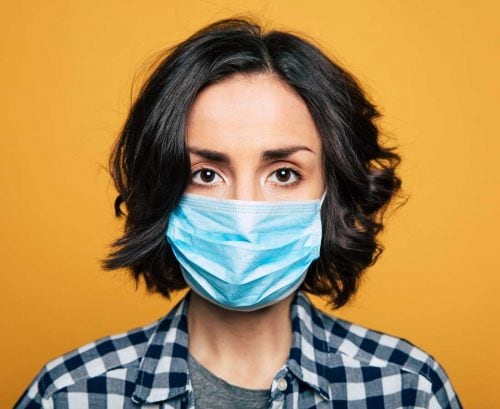
Many of us have been watching with morbid fascination as the number of coronavirus cases and deaths grows around the world. Among the coronavirus numbers published each day is a tally of those who have recovered. But what does this mean, when it comes to COVID-19, and how long can a person remain infectious? Healthy Food Guide editor Jenny de Montalk investigates.
At the time of writing [16 April 2020], there are have been 2,075,528 coronavirus cases worldwide. Sadly, 134,286 people have died. A documented 509,577 people have recovered.
Those stark numbers reveal a lot about COVID-19. They show this is a virus that spreads fast. On 22 January there were 580 confirmed cases recorded. Confirmed cases have exponentially grown beyond 2 million, in a matter of months.
The numbers also show coronavirus COVID-19 is serious, it can and does kill. Of active cases worldwide, 4 per cent are in a serious or critical condition. And of closed cases, the outcome was death for 21 per cent. But that also means 79 per cent have recovered.
To understand what it means to be recovered, first it makes sense to look at the path of infection with coronavirus.
How long does it take for coronavirus symptoms to show?
When we catch a virus there’s usually a period of time between being exposed to that virus and symptoms of the disease showing up. This is called the incubation period.
According to a review of publicly reported cases, between 4 January and 24 February this year, most people show signs of COVID-19 between four and six days after exposure, and 97.5 per cent of people develop symptoms within 15 days of exposure.
This is why a 14-day period of self-isolation, quarantine or active monitoring of possible cases has been employed in most places around the world. If you’re going to have symptoms of COVID-19, that’ll be enough time for them to show up.
How long are COVID-19 cases sick for?
Most people have a mild illness, if infected with coronavirus, and they recover after about two weeks. Around 20 per cent of people are hospitalised with severe breathing difficulties, and six per cent of those cases go on to be critical.
It appears to take about a week to get to the severely ill level, if that’s where you’re headed. The median time for recovery for severely or critically ill patients is three to six weeks, according to the World Health Organization.
How long are people with coronavirus infectious for?
The most infectious period for someone with coronavirus is thought to be in the one to three days before your symptoms start (which is why it’s so important to isolate yourself if there’s a chance you’ve been exposed) and the seven to 12 days after, for mild to moderate cases. In severe cases, the most infectious period can be up to two weeks after symptom onset.
At this stage, it’s not completely certain how long a person with COVID-19 remains infectious for.
Viral shedding, through nose, mouth and throat droplets, has been reported in Singapore patients up to 24 days after symptom onset, according to the European Centre for Disease Prevention and Control.
And presence of the virus in faeces has been detected up to five weeks after onset of symptoms, but no one is sure yet if that presents a danger for transmission.
When is a person considered recovered from coronavirus?
The timeframe for this varies slightly from country to country. In most places, a person is considered recovered and no longer infectious if they have been symptom-free for three days and it has been 10 or more days since the onset of their symptoms. In New Zealand, people are given the all-clear if they’ve been symptom-free for 48 hours and it has been more than 10 days since symptom onset.
More research is needed to find out if people are potentially infectious, or not, if they still have detectable traces of the virus but have recovered.
In New Zealand self-isolation can only end once a person is cleared by their doctor.
Why don’t they just test recovered cases again?
This appears to come down to prioritisation of resources. The number of coronavirus tests is finite, so most governments have set criteria for testing.
Retesting people who have only had a mild illness is not considered necessary, in some countries. But hospitalised patients are generally retested, prior to discharge.
Once a person has recovered from COVID-19 are they immune?
It’s too soon to tell but it looks likely, at least for a period of time, that people who have been infected and have recovered from COVID-19 will have some immunity against it.
Reports of patients being infected more than once have, so far, been anecdotal.
Researchers in a small animal trial on four adult rhesus macaques were not able to re-infect the monkeys after they recovered from initial infection with SARS-CoV-2.
Article sources and references
- ei WE, Li Z, Chiew CJ, Yong SE, Toh MP, Lee VJ. Presymptomatic Transmission of SARS-CoV-2 — Singapore, January 23–March 16, 2020. MMWR Morb Mortal Wkly Rep 2020;69:411–415. DOI: http://dx.doi.org/10.15585/mmwr.mm6914e1externalhttps://www.cdc.gov/mmwr/volumes/69/wr/mm6914e1.htm
- Report of the WHO-China Joint Mission on Coronavirus Disease 2019 (COVID-19) - World Health Organizationhttps://www.who.int/docs/default-source/coronaviruse/who-china-joint-mission-on-covid-19-final-report.pdf
- Stephen A. Lauer, MS, PhD *; Kyra H. Grantz, BA *; Qifang Bi, MHS, et al. The Incubation Period of Coronavirus Disease 2019 (COVID-19) From Publicly Reported Confirmed Cases: Estimation and Application. Annals of Internal Medicinehttps://annals.org/aim/fullarticle/2762808/incubation-period-coronavirus-disease-2019-covid-19-from-publicly-reported
- Novel coronavirus (SARS-CoV-2) TECHNICAL REPORT. Discharge criteria for confirmed COVID-19 cases – When is it safe to discharge COVID-19 cases from the hospital or end home isolation? European Centre for Disease Prevention and Controlhttps://www.ecdc.europa.eu/sites/default/files/documents/COVID-19-Discharge-criteria.pdf
- Linlin Bao, Wei Deng, Hong Gao, et al. Reinfection could not occur in SARS-CoV-2 infected rhesus macaques. doi: https://doi.org/10.1101/2020.03.13.990226. bioRxivhttps://www.biorxiv.org/content/10.1101/2020.03.13.990226v1.full
- COVID-19 CORONAVIRUS PANDEMIC. Worldometershttps://www.worldometers.info/coronavirus/
www.healthyfood.com










